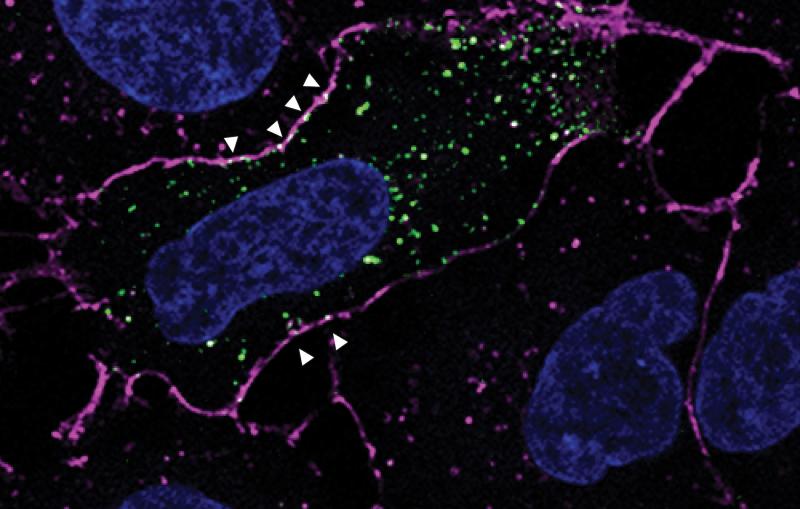Peter Chung wins 2020 Spicer Young Investigator Award for work on neurodegenerative disease
Chung is being recognized for pathbreaking contributions to the study of proteins involved in Parkinson’s and Alzheimer’s diseases and for mentoring the next generation of synchrotron scientists.
Peter Chung, the Kadanoff-Rice Postdoctoral Fellow at the University of Chicago, wants to understand neurodegenerative disease in its finest detail, at the level of proteins that form tangles in neurons and lead, researchers believe, to ailments including Parkinson’s and Alzheimer’s diseases.
Chung has spent much of his career running experiments on the biological small-angle X-ray scattering (bioSAXS) Beam Line 4-2 at the Stanford Synchrotron Radiation Lightsource (SSRL) aimed at untangling the mysteries of those proteins, often developing new methods to do so, and for his efforts, he has won SSRL’s 2020 Spicer Young Investigator Award.
Chung began visiting SSRL in 2006 as an undergraduate student at University of California, Berkeley, where he studied liquid crystals, but his interests soon shifted.
“I certainly loved the research and found the problems interesting to think about, but I needed more,” Chung said, citing the great opportunities that had been afforded him – he attended Berkeley on a full financial-need scholarship and was fortunate, he said, to have had excellent teachers and mentors. “I guess on reflection on how things could have turned out for me, I was extremely lucky, and since I was given so much to get to that point and even think about life as a physicist, I ought to give back at least as much as I was given.”
By the time Chung was working on his PhD with Cyrus Safinya – another longtime SSRL user at University of California, Santa Barbara – that desire to give back led Chung to explore biological problems, including better understanding Tau proteins, accumulations of which have been linked to Alzheimer’s.
Such proteins, Chung explained, are “intrinsically disordered,” meaning that they do not form well-folded structures, but in disease form twisted, tangled bundles.” That lack of structure is not always a bad thing – in fact, cells can use the bundles to transport molecules around and perform other essential functions. But they can and do cause problems that leave people struggling to move or to recall beloved memories.
To make better sense of these proteins’ effects on our minds, Chung has used small-angle X-ray scattering, a method for uncovering the larger-scale structure of macromolecules. He said he is particularly proud of his work on Tau, for which he helped develop new methods to examine how proteins respond to varying levels of pressure. Those efforts yielded some of the first measurements of Tau’s mechanical properties, which in turn provided new clues about how Tau proteins attach to structures within neurons, altering their functions. He has continued to study Tau, alpha-synuclein and others, with an eye toward understanding how they go from floating freely to aggregating around neurons, preventing them from working properly.
Chung said SSRL was the ideal place to work on a problem that spans everything from polymer physics to neurobiology. “SSRL is unique because it really fosters people from different disciplines to come in and work together to do science,” Chung said. “I was fortunate to actually get a career started at SSRL.”
In a letter nominating Chung for the award, SSRL’s Thomas Weiss, who leads the bioSAXS efforts at SSRL, wrote that he first met Chung when he was a young graduate student at the University of California, Santa Barbara, working on understanding the properties of proteins involved in neurodegenerative diseases.
“I vividly remember the many discussions I had with him about improvements in the current setup to help his scientific goals,” Weiss wrote. “During the time I have known him he grew from a promising and curious graduate student doing experimental work at SSRL to an expert in synchrotron radiation methods as applied to biological and biophysical questions.”
Beyond conducting his own research, Chung has also focused on mentoring others, a point Weiss emphasized in his letter. “As a testament to his uncommon patience and exceptional enthusiasm for the experimental work, many graduate students in fields as diverse as material science and molecular biology eventually became users at SSRL in their own right almost certainly due, at least in part, to his enthusiastic mentoring,” Weiss wrote.
Chung said, “One of the big things that’s really important to me is the training experience. I’m really proud of the fact that I’ve had undergraduates that go on to grad school, and some of them are going to continue using X-ray scattering in their research careers.”
The Spicer Award will be presented to Chung during the 2020 SSRL/LCLS Annual Users' Meeting and Workshops at SLAC, which will be held online Sept. 28 – Oct. 9. The award is named in honor of the late Stanford University Professor William Spicer and his wife Diane. William Spicer was a co-founder of the Stanford Synchrotron Radiation Project in 1972, which later became SSRL.
SSRL is funded by the Department of Energy’s Office of Science and the Structural Molecular Biology Program at SSRL is supported by the DOE Office of Science and by the National Institutes of Health, National Institute of General Medical Sciences.
Contact
For questions or comments, contact the SLAC Office of Communications at communications@slac.stanford.edu.
SLAC is a vibrant multiprogram laboratory that explores how the universe works at the biggest, smallest and fastest scales and invents powerful tools used by scientists around the globe. With research spanning particle physics, astrophysics and cosmology, materials, chemistry, bio- and energy sciences and scientific computing, we help solve real-world problems and advance the interests of the nation.
SLAC is operated by Stanford University for the U.S. Department of Energy’s Office of Science. The Office of Science is the single largest supporter of basic research in the physical sciences in the United States and is working to address some of the most pressing challenges of our time.





